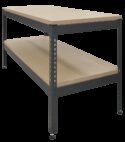Experiment
SM1008

DIAPHRAGM
A self-contained bench mounting experimental apparatus to enable students to investigate the effect of pressure on the surface profile of a diaphragm and also the distribution of circumferential and radial strains.
If you have any questions or you'd like to discuss a product, please call us.
+44 1159 722 611DIAPHRAGM
The Diaphragm apparatus allows students to examine the effect of pressure on the surface profile of a diaphragm. They can also determine the distribution of circumferential and radial strains across its diameter.
A sturdy base contains all parts of the Diaphragm apparatus. This forms a compact product, ideal for use on a workbench.
Two heavy flanges clamp the edge of the diaphragm to provide built-in edge conditions. The area directly under the diaphragm contains oil.
Eight strain gauges are cemented to the top surface of the diaphragm in various positions and at different radii. Each strain gauge circuit is a full bridge, with high-stability resistors. The signals from each strain gauge are shown on a digital display.
A digital dial gauge is fitted to a digital position indicator. The dial gauge can be traversed across the diaphragm to measure its surface profile. Both instruments can connect to TecQuipment’s optional Versatile Data Acquisition System (VDAS®).
Students use a hydraulic pump to increase the oil pressure under the diaphragm. They record the strain readings and diaphragm profile at different pressures.
The results can be taken by hand using the in-built display and pressure gauge and results plotted by hand.
Alternatively, the student can use VDAS® to capture the data and plot the relevant graphs and export data. A user guide is supplied with the Diaphragm apparatus. The guide includes full details of the equipment, detailed experiment procedures, theory and results.
For quick and reliable tests, TecQuipment’s optional VDAS® gives accurate real-time data capture, monitoring and display, calculation and charting of all important readings on a computer.
Learning outcomes
Experiments possible with this apparatus, includes the effect of pressure on:
- Surface profile - the results are presented as a non-dimensional curve
- Radial and circumferential strains
- Radial and circumferential strain gradients across the diaphragm
Experimental measurements are compared with theory. The student is encouraged to determine the accuracy of the location of the strain gauges.










